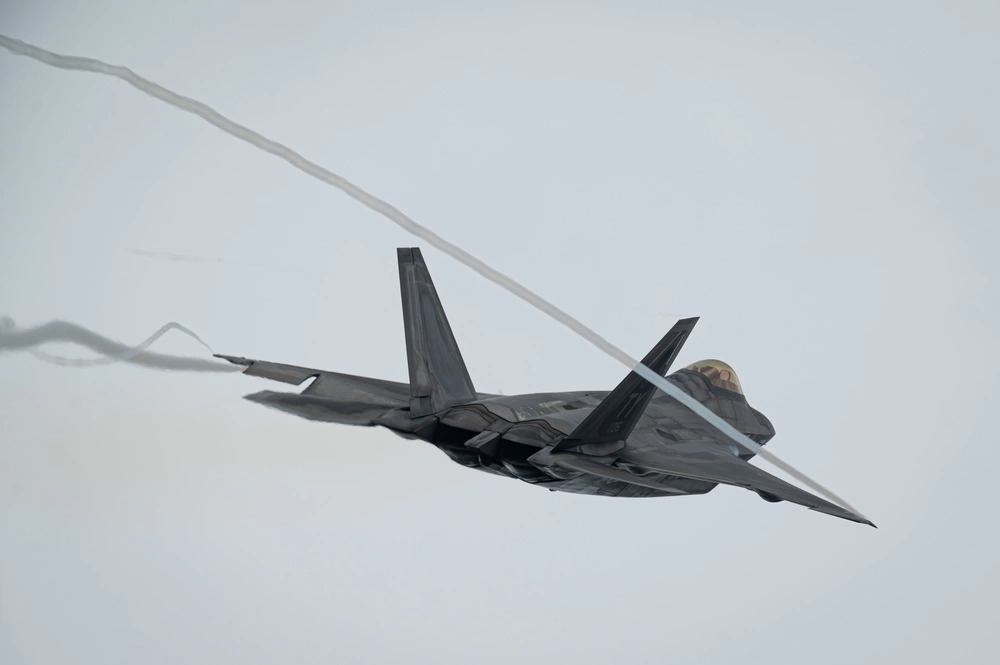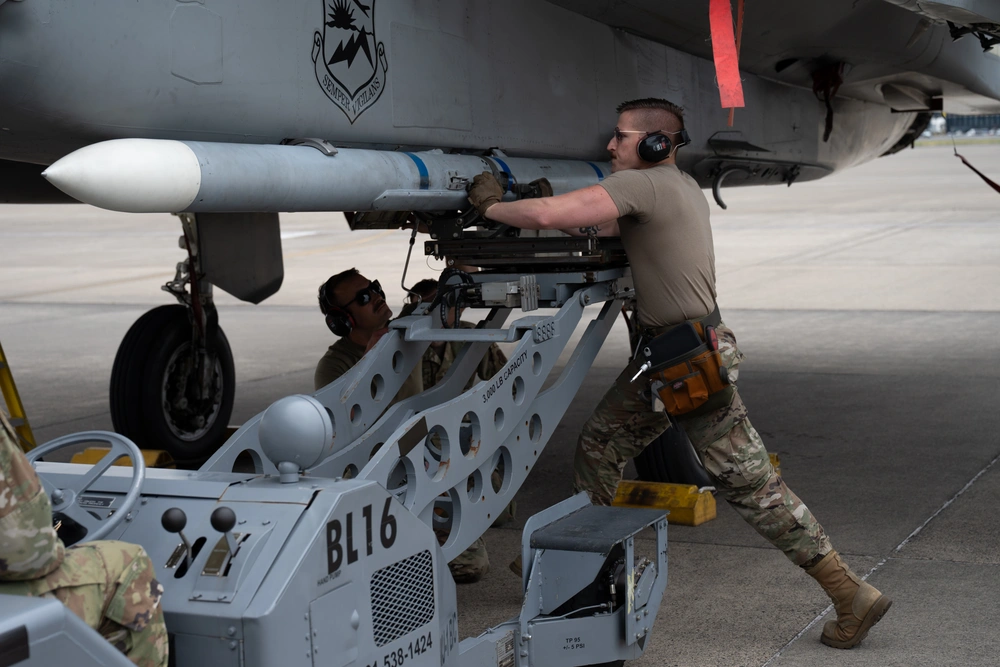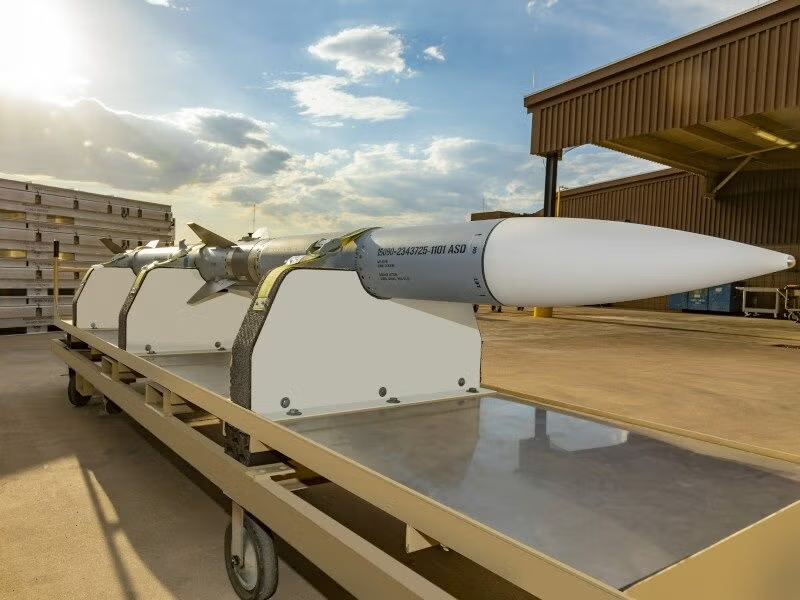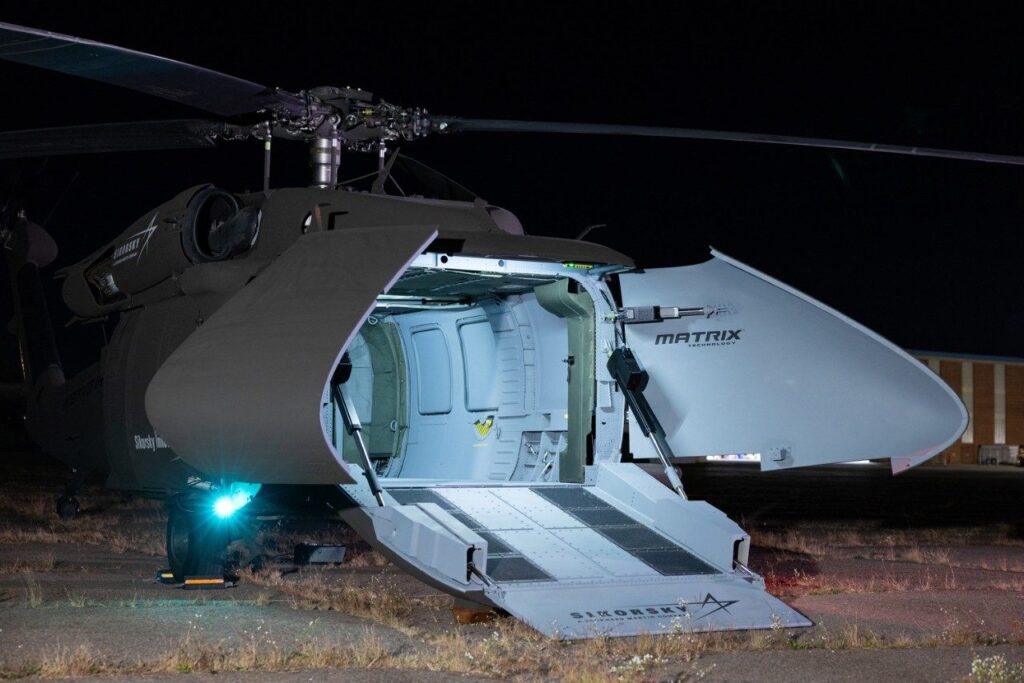F-22 achieves record-breaking shot with Raytheon’s newest AIM-120 missile
- By Alex Hollings
Share This Article

The U.S. Air Force just announced that an F-22 Raptor recently scored the longest known hit on an airborne target using an AIM-120 AMRAAM, or Advanced Medium Range Air-to-Air Missile. The record breaking shot took place near Eglin Air Force Base in Florida last Fall, but hadn’t been disclosed until now. The Air Force didn’t disclose the range of the hit.
This new record supersedes the previously disclosed longest-ever AMRAAM shot, scored by an F-15C Eagle in 2021 against a BQM-167 subscale target drone. And while the range of that hit has also not been disclosed, it was scored with an AIM-120D, which was among the latest iterations of AMRAAM fielded at the time and is believed to have a maximum range of around 100 miles, or just over 160 kilometers. This new hit was scored with the even newer AIM-120 F3R,
While the U.S. Air Force is actively testing Lockheed’s new extremely long-range AIM-260, and the U.S. Navy is now touting its incredible AIM-174, Raytheon, the AIM-120’s manufacturer, is working tirelessly to make its “medium” range air-to-air missile a long-range powerhouse, and the new F3R AMRAAM is unlikely to be the last new development coming out of this program.
Raytheon claims the F3R, which stands for “form, fit, and function refresh” is already allowing pilots “the ability to take shots that are further than they ever imagined before.” All new AMRAAMs come equipped with the F3R upgrade.
And because the improvements are largely software-based, there’s no real change in how the weapon is employed by the pilot, meaning there’s no additional training required to leverage the longer-ranges available in new AMRAAMs rolling out of the production line.
The previous AMRAAM record, set in 2021, was said to be a demonstration of the Air Force’s “long range kill chain capabilities,” which suggests the F-15C likely engaged the target drone without an effective target track from its onboard AN/APG-63(V)2 active electronically scanned array radar. Instead, the missile probably received target data relayed by a nearby airborne warning and control system aircraft, or AWACS.

That capability is an increasingly vital element of America’s long-range air-to-air combat concept of operations, with new missiles like the aforementioned AIM-174 potentially able to hit targets more than 300 miles away. At those ranges, the launching fighter, which in the case of the AIM-174 would be a Navy F/A-18 Super Hornet, can’t even see the missile’s intended target on radar, but can instead rely on the much more powerful arrays found aboard the Navy’s warships and airborne control aircraft for good target tracks. And when it comes to flying into contested airspace, forward advancing stealth F-35Cs can relay target data back to Super Hornets taking up the rear to engage fighters on their behalf, effectively expanding the arsenal available to stealth fighters for the air-to-air fight.
While it’s possible that the F-22 that broke the Eagle’s record may have benefited from the same sort of kill chain, it’s also worth noting that the Raptor’s incredibly advanced AN/APG-77(V)1 array is arguably the most capable air-to-air focused radar on the planet, potentially even outperforming the F-35’s more modern AN/APG-81 against airborne targets. And that’s not the only thing that makes the Raptor uniquely suited for beyond-visual range engagements using the AMRAAM.
Among the upgrades found in the F3R are improved flight profiles meant to take advantage of the high altitude and speeds in which these weapons can be launched by aircraft like the F-22 Raptor which can cruise at higher speeds and reach higher altitudes than most in-service fighters.
The combination of extreme altitude and launch speeds, paired with software changes to the AMRAAM’s flight profile meant to leverage that added energy, leads to achieving very long ranges. This is because of how the maximum ranges of these weapons are determined (and why, depending on context, they can be a bit misleading).
The under-discussed reality of maximum missile ranges is that these figures don’t just include how far the weapon can travel under power, but rather, also how far it can coast after depleting all of its fuel and still feasibly hit a sluggish but airborne target. In fact, long-range air-to-air missiles don’t just travel straight toward their targets, but instead, often climb to much higher altitudes while flying under power. This allows the missile to use the combination of potential energy (altitude) and kinetic energy (speed) to continue closing with a target well after all of its fuel has been expended.
Related: The F-22 Raptor almost had a stealth bomber sibling

The legendary AIM-54 Phoenix missile once carried by F-14 Tomcats, for instance, would famously climb to more than 100,000 feet in altitude after launch, in order to engage incoming bombers at 100 or so miles away. In fact, according to The Warzone, the Phoenix may have even hit targets as far out as a reported 126 or maybe even 132 miles in its prime.
As the missile coasts, air flowing over the its tail fins still allows it to adjust course as it closes with the target. Yet, every change in direction comes at the expense of kinetic and potential energy, reducing the overall range the missile can travel.
So, a maximum range shot can be very effective when shooting at big platforms like bombers, refueling tankers, and airborne command and control aircraft, but isn’t particularly effective against maneuverable targets, like fighters. The missile just doesn’t have enough energy left, in the form of fuel, speed, or altitude, to perform the dramatic aerobatics necessary to close with a nimble jet that’s trying to shake it at max range.
As a result, most air-to-air missiles are only really useful against other fighters at maybe 70% or less of their reported maximum ranges, with the exception of weapons like the MBDA Meteor, which uses a solid-fuel ducted ramjet to control its fuel burn and allow it to fly under power out to further distances.
But that’s not the only way you can improve your chances at scoring a hit at long range. As Raytheon is proving with the AMRAAM, improved software and flight control computers can allow the missile to calculate a more efficient flight path to its target, making it possible to conserve as much potential and kinetic energy as it can, for as long as it can, for increased range and improved kinematics at the point of contact.
And extending these ranges is paramount, as both Chinese and Russian weapons developers have been fielding increasingly long-ranged air-to-air missiles, with China’s PL-15 cited by the Air Force as part of the impetus behind funding the AIM-260 program. The PL-15 is said to be a 200-kilometer, or roughly 125-mile, class weapon, meaning it outranges the AIM-120D and could potentially give Chinese fighters an advantage. China’s still-in-testing but much larger PL-17 (also known as the PL-X) is too large to fit inside the weapons bay of a stealth fighter, but is said to offer up to 400 kilometers in range (nearly 250 miles). However, it is worth noting that most Chinese fighters also still carry PL-12s, the precursor to the new PL-15 that’s more akin to earlier AMRAAM iterations like the AIM-120C.
Related: Smithsonian receives F-15 jet with a special history

The AMRAAM F3R may not the longest ranged air-to-air missile in American service, let alone in the world, but it is among the farthest-reaching and most reliable airborne weapon systems on the planet. To date, AIM-120s have downed at least 16 aircraft in combat, including the most recent American air-to-air victory, when, in 2017, a U.S. Navy F/A-18 Super Hornet took down a Syrian Su-22. Today, at least 43 countries operate some variant of the AMRAAM, accounting for more than a combined 6,000 successful live-fire launches from at least 14 different types of aircraft.
Raytheon, recently claimed that the AMRAAM’s reach is now approaching the lower end of the threshold sought in the new AIM-260 Joint Advanced Tactical Missile program – a new long-range air-to-air missile being fielded to serve as a higher-end option for beyond-visual range engagements, while still maintaining the same form factor to be stowed inside the internal weapon bays of stealth fighters. While not disclosed, the bottom end of the range requirements for the AIM-260 are generally believed to be around 125 miles.
In August, the Pentagon awarded Raytheon a record-breaking $3.5 billion contract for AMRAAM production and sustainment, which also includes producing missiles for foreign military sales to 19 other nations operating the weapon.
The AMRAAM has been in service, in one form or another, since 1991, but has seen extensive updating since the original AIM-120A, which offered a reported range of only around 46 miles (about 75 kilometers). By the time we got to the AIM-120C-7 in the early 2000s, the weapon was given a new rocket motor and increased fuel storage, made possible in part by further miniaturizing the flight control system thus freeing up roughly 15cm worth of interior space. That stretched the AMRAAM’s legs out to better than 56 miles, or around 90 kilometers, but to some extent, the AMRAAM was still a brute-force missile, and it wasn’t until the next upgrade, known as the AIM-120D that the weapon gained some serious technological finesse.
Related: Two new American missiles that will make a bang
The AIM-120D added a two-way data link, an enhanced navigation suite and improved high-off-boresight targeting capabilities, but maybe most notably, a larger motor that increased the AMRAAM’s top speed to above Mach 4 while providing a 50% increase in range, pushing the weapon’s reach out to right around 100 miles, or about 160 kilometers. Further software improvements stretched that out even further in the AIM-120D-3, which is believe to reach out to around 111 miles. And now, it seems, the new F3R can reach even farther than that.
“We were able to fly it much longer. The propulsion and aerodynamic properties off the missile … in that F3R variant … always had the capability to go further. We just had not been able to take advantage of it. So at this point, it’s the way we’re flying it. It’s flying higher and longer. We can fly at a much faster speed at release, which just improves the performance of the missile,” a Raytheon spokesperson told Air & Space Forces Magazine.
Incredibly, Raytheon says they believe they can still pull more range out of the AMRAAM as they continue to refine its flight control software. Also, it’s worth remembering that DARPA’s Longshot program is fielding, what effectively amounts to, air-launched drones that can carry their own pair of AIM-120 AMRAAMs. This would make these weapons that much more dangerous by significantly increasing their reach, but also by allowing a single fighter to engage a target from multiple vectors at once, creating a significant air combat advantage.
And while the AIM-260 is meant to offer superior range and performance while being roughly the same size and shape, that doesn’t mean these new-and-improved AMRAAM AIM-120 are going away. Instead, the Air Force envisions the AIM-120 continuing to serve as the lower-end of a 21st-century high/low mix of Beyond-Vissual-Range missiles, using the lower-cost AMRAAM for targets at the cusp of beyond-visual-range and likely out past 100 miles, and the pricier AIM-260 for targets even farther out.
Feature Image: U.S. Air Force Maj. Josh Gunderson, F-22 Demo Team commander, rolls into a reposition for the next maneuver during a demonstration for the 67th National Security Forum at Maxwell-Gunter Air Force Base, Montgomery, Alabama, May 11, 2021. (U.S. Air Force photo by Master Sgt. Don Hudson)
Read more from Sandboxx News
- Australia’s first collaborative combat aircraft is closer to full operational deployment
- How the Argentinians took out a British warship
- Lockheed wants to give the F-35 a ‘Ferrari upgrade’ to bring in on par with upcoming 6th-gen fighters
- America now has a second B-21 Raider stealth bomber in the sky
- SOCOM’s latest rifles embrace the 6.5 Creedmoor cartridge
Related Posts
Sandboxx News Merch
-

‘AirPower’ Classic Hoodie
$46.00 – $48.00Price range: $46.00 through $48.00 Select options This product has multiple variants. The options may be chosen on the product page -

‘Sandboxx News’ Trucker Cap
$27.00 Select options This product has multiple variants. The options may be chosen on the product page -

‘Kinetic Diplomacy’ Bumper Sticker (Black)
$8.00 Add to cart

Alex Hollings
Alex Hollings is a writer, dad, and Marine veteran.
Related to: Airpower

How Colombia’s drug cartels almost bought a Soviet submarine

How much does it cost to train an Air Force pilot? A LOT

The untold history of the Soviet Union’s weapons testing in space

Iconic Black Hawk helicopter has been turned into a drone
Sandboxx News
-

‘Sandboxx News’ Trucker Cap
$27.00 Select options This product has multiple variants. The options may be chosen on the product page -

‘AirPower’ Classic Hoodie
$46.00 – $48.00Price range: $46.00 through $48.00 Select options This product has multiple variants. The options may be chosen on the product page -

‘AirPower’ Golf Rope Hat
$31.00 Select options This product has multiple variants. The options may be chosen on the product page -

‘Sandboxx News’ Dad Hat
$27.00 Select options This product has multiple variants. The options may be chosen on the product page
